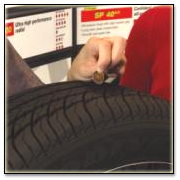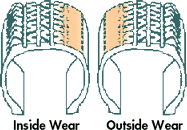Check Your Tire Inflation
Proper tire inflation is essential for safe driving and long tire life. It's wise to check your tires' air pressure at least once a month with an accurate tire pressure gauge. Be sure to check pressure while your tires are cold and have not been used recently. Even driving a mile will cause your tire pressure to increase and give you an inaccurate reading.
Should you experience continuous loss of inflation pressure, it could be an indication of a possible tire or wheel assembly problem. Consult your tire professional immediately if you encounter this situation.
Check Your Tire Tread
There are two popular ways to check for signs of tire tread wear. One easy way is the penny test. Simply insert a penny into your tire's tread groove with Lincoln's head upside down and facing you. If you can see all of Lincoln's head, it's time to replace your tires.
Another way is to look at the tread wear indicator bar that's molded into your tires. The bars are located at the bottoms of the tread grooves in several locations around the tire. When a tire is so worn that these bars become visibly flush with the adjacent tread ribs, it's time to replace the tire.
Goodyear suggests you check your tire tread using either method every 3,000 miles.
Know What Certain Wear Patterns Mean
As tires wear, sometimes wear patterns emerge that can indicate problems with your vehicle or tires. If you see any of these patterns, have your tires checked by a professional Goodyear Retailer. Here are some wear patterns to watch for.
"� Wear on both edges: UNDERINFLATION
Underinflation of a tire reduces its treadlife by increasing the tread wear on its outside edges, or shoulders. It also generates excessive heat which reduces tire toughness. Finally, it reduces fuel economy through increased rolling resistance because soft tires make your vehicle work harder. Abnormal tire wear may also be caused by misalignment or mechanical problems.
"� Wear in center: OVERINFLATION
When a tire is overinflated, the center of the tread bears most of the load and wears out faster than the outside edges. Uneven wear reduces the useful life of a tire. It could also be the result of misalignment or mechanical problems.
"� Cups or dips in the tread: WORN PARTS
Cupping (also called dipping) is most common on front tires, although rear tires can cup as well. It may be a sign that wheels are out of balance or that suspension or steering system parts are worn out.
"� Sawtooth edges: MISALIGNMENT
If the edges of your tire tread take on a sawtooth or feathered appearance, it's because of erratic scrubbing against the road. The solution is an alignment correction.
Tire Balancing
If your tires are unbalanced, you'll notice vibration. This can lead to driver fatigue, premature or irregular tire wear and unnecessary wear to your vehicle's suspension. Your tires should be balanced when they are mounted on wheels for the first time or when they are remounted after repair. Check your tire balance at the first sign of vibration or shimmy.
Vehicle Alignment
Your vehicle is properly aligned when all of its suspension and steering components are working smoothly and when its tire and wheel assemblies are running straight and true. If you notice uneven tread wear, it could be due to a misalignment and your vehicle should be serviced by a professional.
Tire Rotation
While many people are knowledgeable enough to rotate their own tires, the procedure is especially quick and easy for a professional. Your vehicle's owner's manual will specify the proper rotation pattern and schedule for your vehicle. If no specific schedule is indicated, a good rule of thumb is to rotate your tires every 6,000 to 8,000 miles.
Tire Repair
Tire repairs should be made by a trained tire professional. Proper repair procedure includes dismounting the tire from the wheel. This allows for thorough inspection of the tire for damage, as well as the use of a patch and plug to repair any punctures that fall within the guidelines for repair.
Tire Buying Guide
Download a pdf of the Goodyear Tire Buying Made Easy Guide. You will need Adobe Acrobat to view the pdf.
The Goodyear Get there� � � Guide
Fun-filled ideas for your next family road trip. Tire TipsDriving TipsTire SafetyReading A TireTire MaintenancePrepare Your Vehicle
For WinterFAQsFind A Goodyear Retailer





Thursday, April 3rd, 2008 AT 8:42 PM







